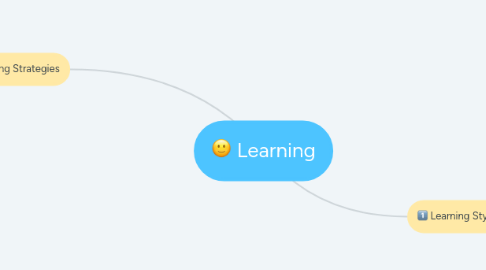
1. Lerning Strategies
1.1. Types
1.1.1. Cognitive strategies
1.1.1.1. learning management
1.1.1.1.1. repetition
1.1.1.1.2. organising new language
1.1.1.1.3. summarising meaning
1.1.1.1.4. guessing meaning from context
1.1.1.1.5. using imagery for memorisation
1.1.1.2. Activitiy
1.1.1.2.1. making mind maps
1.1.1.2.2. visualisation
1.1.1.2.3. underlining key words
1.1.1.2.4. using clues in reading comprehension
1.1.1.3. Example
1.1.1.3.1. A student learns new words by imagining them in an entertaining or memorable setting. This makes remembering these words easier and faster.
1.1.2. Metacognitive strategies
1.1.2.1. learning management
1.1.2.1.1. evaluating task success,
1.1.2.1.2. evaluating task mistakes
1.1.2.1.3. arranging a study space
1.1.2.1.4. arranging a schedule
1.1.2.2. Activities
1.1.2.2.1. Think Aloud
1.1.2.2.2. Checklist, Rubrics and Organizers
1.1.2.2.3. Explicit Teacher Modeling
1.1.2.3. Example
1.1.2.3.1. teachers read a story or problem out loud and periodically stop to verbalize their thoughts. This allows students to follow the teacher’s thinking process, which gives them the foundation they need for creating their own strategies and processes that can be useful for understanding what they are trying to comprehend.
1.1.3. Memory-related strategies
1.1.3.1. help learners link one L2 item or concept with another
1.1.3.2. do not necessarily involve deep understanding.
1.1.3.3. allow students to learn and retrieve knowledge in a logical sequence
1.1.3.4. mental processes for storing new information in the memory and for retrieving them when needed.
1.1.3.5. Methodology set
1.1.3.5.1. creating mental linkages
1.1.3.5.2. applying images and sounds
1.1.3.5.3. reviewing well
1.1.3.5.4. employing action
1.1.4. Compensatory strategies
1.1.4.1. supply the knowledge gaps that a learner may have either in speaking or writing,
1.1.4.2. overcoming language difficulties.
1.1.4.3. As Oxford says compensation strategies are employed by learners when facing a temporary breakdown in speaking or writing
1.1.4.4. Methodology
1.1.4.4.1. guessing intelligently
1.1.4.4.2. overcoming limitations in speaking and writing.
1.1.4.5. Example
1.1.5. Affective strategies,
1.1.5.1. concerned with the learner’s emotional requirements
1.1.5.2. Methodology
1.1.5.2.1. assisting them to cope with their emotions
1.1.5.2.2. give them motivation
1.1.5.2.3. assisting them to cope with their attitudes
1.1.5.3. Example
1.1.5.3.1. rewarding oneself for good performance,
1.1.5.3.2. using deep breathing or positive self- talk
1.1.6. Social strategies
1.1.6.1. increased interaction with the target language
1.1.6.2. Methodology
1.1.6.2.1. asking questions
1.1.6.2.2. cooperation with others
1.1.6.2.3. emphasizing with others
2. Learning Styles
2.1. Types
2.1.1. Sensory Preferences
2.1.1.1. visual
2.1.1.2. auditory
2.1.1.3. kinesthetic (movement-oriented)
2.1.1.4. tactile (touch-oriented)
2.1.2. Personality Types
2.1.2.1. extraverted vs. introverted
2.1.2.2. intuitive-random vs. sensing-sequential
2.1.2.3. thinking vs. feeling
2.1.2.4. closure-oriented/judging vs. open/perceiving
2.1.3. Desired Degree of Generality
2.1.3.1. Global or holistic
2.1.3.2. Analytic students
2.1.4. Biological Differences
2.1.4.1. Biorhythms
2.1.4.2. Sustenance
2.1.4.3. Location
